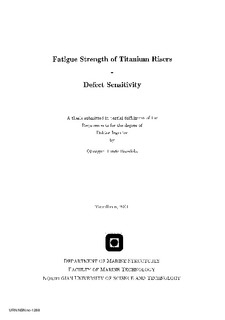Fatigue Strength of Titanium Risers - Defect Sensitivity
Doctoral thesis
Permanent lenke
http://hdl.handle.net/11250/231182Utgivelsesdato
2001Metadata
Vis full innførselSamlinger
Sammendrag
This study is centered on assessment of the fatigue strength of titanium fusion welds for deep-water riser’s applications. Deep-water risers are subjected to significant fatigue loading.
Relevant fatigue data for titanium fusion welds are very scarce. Hence there is a need for fatigue data and life prediction models for such weldments.
The study has covered three topics: Fatigue testing, Fractography and defect assessment, and Fracture Mechanics modelling of fatigue crack growth.
Two series of welded grade of titanium consisting of 14 specimens in each series were fatigue tested under constant amplitude loading. Prior to fatigue testing, strain gauge measurements of some specimens was conducted to enable the definition of stress range in the fatigue assessment procedure. The results were compared with finite solid element analysis and related to fatigue stresses in a riser pipe wall.
Distribution and geometry of internal and surface defects both in the aswelded and in the post-welded machined conditions were assessed using fractography. This served as a tool to determine the fatigue initiation point in the welds.
Fracture mechanics was applied to model fatigue strength of titanium welds with initiation from weld defects. Two different stress intensity factor formulations for embedded eccentrically placed cracks were used for analysis of elliptical cracks with the major axis parallel and close to one of the free surface. The methods were combined to give a satisfactory model for crack growth analysis.
The model analyses crack growth of elliptical and semi-elliptical cracks in two directions, with updating of the crack geometry. Fatigue strength assessment was conducted using two crack growth models, the Paris-Erdogan relation with no threshold and the Donahue et al. relation with an implied threshold.
The model was validated against experimental data, with a discussion on the choice of crack growth model.
